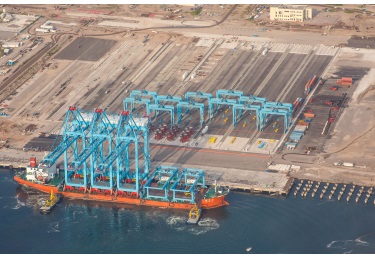Facility Expansion: Hawaii, Lázaro Cárdenas
![]() Print this Article | Send to Colleague
Print this Article | Send to Colleague
Honolulu: Relocation of UH Marine Center makes way for Kapalama Container Terminal improvements
The Hawaii Department of Transportation’s Harbors Division (HDOT) has taken the next step in making reality of the planned Kapalama Container Terminal (KCT) in Honolulu Harbor.
The Department, along with elected officials and representatives of the University of Hawaii (UH), conducted a blessing and key ceremony to formally convey the newly renovated Pier 35 facility to the UH School of Ocean and Earth Science and Technology (UH SOEST) on March 30. The relocation is a vital component of the Harbors Modernization Plan (HMP). It provides for a larger, more flexible berthing area for UH SOEST vessels at Pier 35 and clears the way for the KCT development project to proceed.
HDOT is developing the proposed KCT facility at the former Kapalama Military Reservation (KMR) to address the critical need for new container terminal space and resolve the shortage of cargo handling capacity issues at Hawaii’s busiest commercial harbor.
HDOT broke ground for the UH SOEST project in March 2014 and completed the facility improvements in the fall of 2015 to accommodate the relocation of UH SOEST program from Snug Harbor as a key component of the statewide HMP development of the new Kapalama Container Terminal.
The $17 million project is an investment in renovating aging harbor facilities. It involved partial demolition and renovations to the Pier 35 building including construction of a new elevator, stairs, offices, restrooms, air conditioning, fire alarm systems, lighting, and electrical improvements. Exterior facility upgrades included drainage, utility, water, sewer, power, and communications improvements, and installed new asphalt and concrete pavement within the project site. In keeping with the terms of the original lease, UH SOEST will be allowed to utilize this new facility free of charge with the understanding that at the end of the term it will revert to market rent.
The HMP is a comprehensive plan to revitalize and upgrade Hawaii’s commercial harbor facilities. The efficient operations at Hawaii’s port harbors are extremely important to the state’s economy. Approximately 80 percent of all goods consumed in Hawaii are imported and nearly 99 percent of those goods pass through Hawaii’s commercial harbors.
APM Terminals Readies Lázaro Cárdenas TEC2 Container Terminal
APM Terminals says it is pressing forward with the new deep-water semi-automated TEC 2 container terminal in the Port of Lázaro Cárdenas with the full expectation that the 1.2 million TEU annual throughput of additional capacity will have an immediate impact on Mexico’s local and international trade growth. The company’s commitment to the USD $900 million project comes at a time of lagging global and regional Latin American economic growth, and sluggish global container shipping growth rates.
"Mexico is not only the second-largest economy in Latin America, but also one of the world’s Top 15 manufacturing economies, including having become one of the world’s top five car makers, and we feel that investing in Mexico’s continuing economic and trade progress is a sound business strategy" stated APM Terminals CEO Kim Fejfer, who toured the TEC2 site on Mexico’s Pacific Coast last month.
Manufacturing and the supply of components destined for Mexican factories for assembly and export to the USA, as well as overseas, has become an increasingly important sector of Mexico's $1.16 trillion economy since the North American Free Trade Agreement (NAFTA) linked the U.S., Canadian, and Mexican markets 22 years ago.
APM notes that Mexican port container throughput in 2015 increased 7 percent in 2015 (to 5.4 million TEUs), far outperforming global container market growth of just over 1 percent for the year. Throughput at Lázaro Cárdenas rose 6.0 percent to 1.05 million TEUs, second only to Manzanillo’s 2.4 million TEUs among Mexico’s busiest container ports.
At full build-out, TEC2 will double the quayside to 1,485 meters, increase the number of ship-to-shore cranes from seven to fifteen, and more than double annual throughput capacity to 4.1 million TEUs. TEC2 will be linked intermodally to the U.S. rail network and to Mexico’s most important consumer market, the Mexico City area, generating 26 percent of Mexico’s economic output, with a population of 20 million, including a substantial and rising middle class of consumers.
With the completion this March of its acquisition of Grup Maritim TCB’s Latin American assets, the APM Terminals Global Terminal Network has added operations in Puerto Progreso, on Mexico’s Gulf Coast. APM Terminals’ other Latin American operations now include interests in two terminals in Colombia, one in Peru, one in Argentina, and four in Brazil, with new terminals in development in Quetzal, Guatemala, and Moin, Costa Rica.
"We view the Latin American market, and particularly Mexico, as an area of great opportunity" said Mr. Fejfer.

Delivery of container cranes to Lázaro Cárdenas
Photo/APM Terminals

